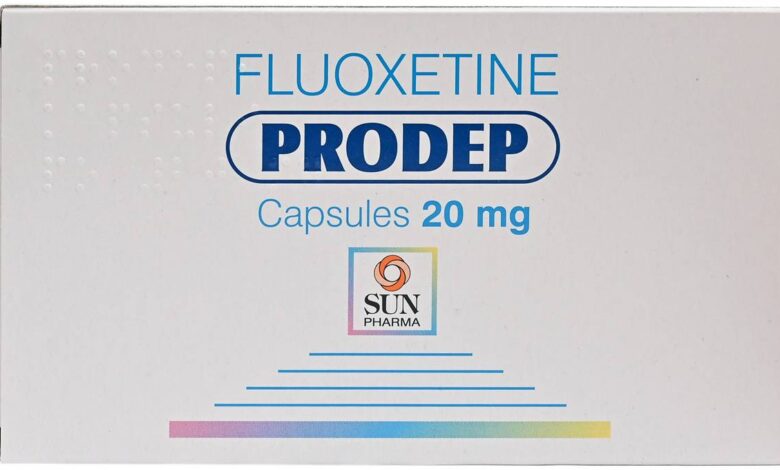PRODEP: instructions for using the medicine, structure, Contraindications

Active material: Fluoxetine
When ATH: N06AB03
CCF: Antidepressant
When CSF: 02.02.04
Manufacturer: Sun Pharmaceutical Industries Ltd. (India)
Pharmaceutical form, composition and packaging
| Capsules | 1 caps. |
| fluoxetine hydrochloride | 20 mg |
10 PC. – aluminum strips (6) – packs cardboard.
Pharmacological action Prodep
Antidepressants, selective serotonin reuptake inhibitor. It improves mood, reduce tension, anxiety and a sense of fear, eliminates dysphoria. It does not cause orthostatic hypotension, Sedation, nekardiotoksichen. Persistent clinical effect after 1-2 weeks of treatment.
Indications for use Prodep
Depression (irrespective of the degree of depressive disorders – poor, moderate, heavy), Bulimia, anorexia, alcoholism, obsessive-compulsive disorder.
Contraindications Prodep
Hypersensitivity, CRF (CC less than 10 ml / min), severe hepatic insufficiency, suicidal thoughts, simultaneous MAO inhibitors (in the previous 2 Sun), pregnancy, lactation. Diabetes, epileptic syndrome of different genesis and epilepsy (incl. history), Parkinson's disease, compensated kidney and / or liver failure, kaxeksija.
Side effects of Prodep
From the nervous system: dizziness, headache, drowsiness or insomnia, slackness, fatigue, asthenia, tremor, ažitaciâ, anxiety, suicidal tendencies (inherent in patients with depressive disorders), mania or gipomaniya. From the digestive system: decreased appetite, dry mouth or hypersalivation, nausea, diarrhea. Allergic reactions: skin rash, hives. Other: increased perspiration, loss of flesh, decreased libido, systemic disorders of the lung, kidney or liver disease, vaskulity.Peredozirovka. Symptoms: nausea, vomiting, state of excitement, convulsions. Treatment: gastric lavage, appointment of activated carbon, with cramps – anxiolytic drugs (trankvilizatorov), simptomaticheskaya therapy.
Dosage and administration Prodep
Inside, depression initial dose – 20 mg / day 1 time, morning; if necessary increase dose at weekly 20 mg / day. The maximum daily dose – 80 mg 2-3 admission. With bulimia, and for elderly patients – 60 mg 3 admission, while obsessive-compulsive disorder – 20-60 mg / day. Maintenance therapy – 20 mg / day. A course of treatment – 3-4 Sun.
Special instructions Prodep
In the treatment of patients with deficiency of body weight should be considered anorectic effects (possible the progressive loss of body weight). In patients with diabetes mellitus appointment fluoxetine increases the risk of hypoglycemia and hyperglycemia – while its abolition. In this regard, the dose of insulin and / or any other. hypoglycemic drugs, Administered orally, It should be adjusted. Prior to the significant improvement in the treatment of patients should be under a doctor's supervision. During treatment should refrain from receiving ethanol and Occupation potentially hazardous activities, require attention and speed of mental and motor responses. The interval between the end of MAO inhibitor therapy and initiation of treatment with fluoxetine should be at least 14 days; between the end and the beginning of treatment with fluoxetine therapy MAO inhibitors – no less 5 Sun. In diseases of the liver and in the elderly, treatment should begin with 1/2 dose.
Interaction Prodep
It enhances the effects of alprazolam, diazepama, ethanol and hypoglycemic drugs. Increases in plasma concentration of phenytoin, tricyclic antidepressants, Maprotiline, trazodone 2 times (necessary to 50% reduce the dose of tricyclic antidepressants, while the application).
Against the background of electroconvulsive therapy may develop prolonged seizures. Tryptophan enhances the serotonergic properties of fluoxetine (increased agitation, motor restlessness, disorders of the gastrointestinal tract). MAO inhibitors increase the risk of serotonin syndrome (hyperthermia, chills, increased perspiration, myoclonus, hyperreflexia, tremor, diarrhea, impaired coordination of movements, vegetative lability, excitation, delirium and coma). PM, providing a depressing effect on the central nervous system, increase the risk of side effects and increased inhibitory action on the central nervous system. In an application with drugs, has a high degree of protein binding, especially with anticoagulants and digitoxin, possible to increase the plasma concentrations of free (unbound) Drugs and an increased risk of adverse effects.
